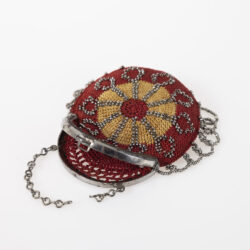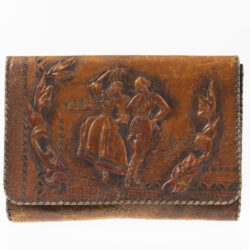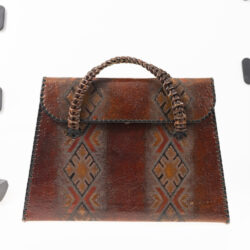Exhibition open until April 14
EVERYDAY COMPANIONS
Handbags 1900–1950
From the first handbag to a meaningful companion
For centuries, people have used bags for storing and carrying necessary items but only during the past hundred years the handbag has become, especially for women, a necessary and irreplaceable accessory. On the one hand, a bag is a practical accessory that fits everything and it has even been compared to a take-along home; on the other hand, the bag as a daily companion shows the fashion sense and social position of its owner. The shape, size, material, colour and decorations of the bag reflect the identity of the possessor, while the content conceals the personal and the private. Such ambivalence has turned the handbag into an important utility item. Handbags also reflect the role of women and the daily needs that have changed in time.
This exhibition looks back to the history of handbags during the first half of the 20th century. The overview starts with the turn of the century when, thanks to the urbanisation and increased mobility caused by the industrial revolution, the weatherproof bag carried by the handle became a part of a woman’s wardrobe. Handbag quickly became an irreplaceable symbol of personal independence. New needs of women and the innovative and conceptual approaches characteristic to the 1920s and 1930s developed the handbag design more than ever: new types of bags appeared with shapes never seen before and made of a wide range of new materials. Handbags became widely used everyday items that started to change in parallel with clothing fashion. The first social rules and agreements towards carrying a handbag were established. The increasing demand for handbags resulted in mass production of handbags. The overview of the exhibition ends with the years after the Second World War when the development of handbag design slowed down and remained mainly within the boundaries of repetition and simplification.
Thanks to magazines and newspapers, all the ideas presented in the large fashion centres spread across Europe and found use in the production of local masters. Bag designs were adjusted according to local taste and demand or developed further towards original and unique items. This exhibition focuses on the rarely discussed history of bags in Estonia which combines international trends with the ideas and skills of local masters. One hundred bags selected from across Estonia showcase the most popular types of bags of each decade, the most important innovations of the subject field and the most characteristic details that reflect changes in the society including aesthetic preferences.
The bags displayed in the exhibition come from the collections of Tallinn City Museum, Estonian History Museum, Estonian National Museum, Pärnu Museum, Narva Museum and Virumaa Museums, Palamuse O. Lutsu Parish School Museum and Rannarhava Museum and the private collection of Jaana Päeva.
The exhibition is open:
The exhibition will be open at the Tallinn City Life Museum until April 14, 2024.
Käekott TLM 14524 KA 4272 https://www.muis.ee/museaalview/1188811
Käekott TLM 20589 KA 6802 https://www.muis.ee/museaalview/2426534
Käekott TLM 15696 H 1698 https://www.muis.ee/museaalview/1900284
Käekott TLM 17322 KN 210 https://www.muis.ee/museaalview/1333629
Tantsijatega käekott – Jaana Päeva kogust
Käekott TLM 17323 KA 5521 https://www.muis.ee/museaalview/2572026
Käekott TLM 18432 KN 246 https://www.muis.ee/museaalview/1203559
Tekstiilist käekott ERM A 974:50 https://www.muis.ee/museaalview/896644








